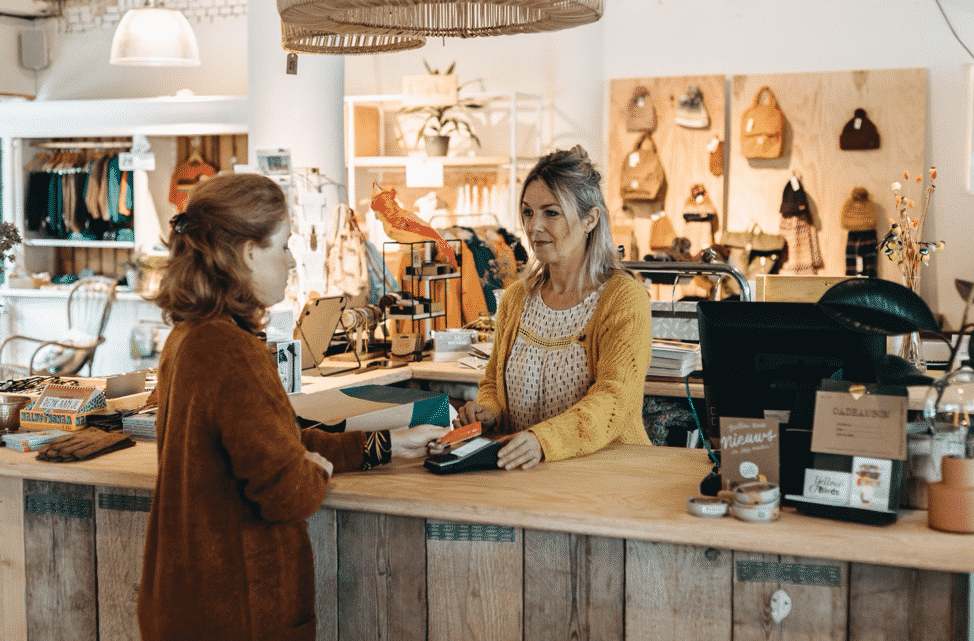![]() Photo by Tristan Colangelo on Unsplash
Photo by Tristan Colangelo on Unsplash
As a store owner, you know about the soaring rise of eCommerce, and it’s true – the global eCommerce sector will be worth over $4.6 trillion by 2022. It’s also true that growth in turnover for brick-and-mortar stores in Western Europe has slowed, begging the question: what does the future hold for shops?
As eCommerce continues to innovate in creative ways, it is certainly a force here to stay – but this doesn’t tell the whole story. The surprising news is that younger generations actually love the brick-and-mortar shopping experience, and this is giving a welcome boost to physical stores.
In this article, we’ll introduce different generations – Baby Boomers, Gen X, Gen Y (Millennials), and Gen Z. We’ll see exciting facts and figures that show younger generations to be active and enthusiastic about going shopping, not just tapping or clicking to buy products on their digital devices.
Facts and Figures: Young People’s Shopping Experience
It’s easy to assume that the older generations (e.g. “Baby Boomers” born 1946-1964) are more likely to shop in-store than online, because they aren’t digital natives – they haven’t grown up with digital technology at the heart of their daily lives. But surprisingly, many studies show that Millennials (born 1981-1996) and Generation Z (aka Gen Z, born 1995-2015) are keen to do their shopping in person:
- One Shopkick survey found that 55% of Gen Z respondents said they’d do the majority of their holiday shopping in stores – compared to slightly fewer (54%) Baby Boomers who said the same.
- An Oracle NetSuite study discovered a more striking difference in generational shopping habits. They determined that Gen Zers and Millennials are more likely to shop mainly in-store than older people. That is, 43% of these younger generations compared to 29% of Gen Xers (born 1964-1979) and 13% of Baby Boomers.
- In one survey conducted by A.T. Kearney, researchers learned that 81% of Gen Z shoppers (14-24 years old) prefer shopping in-store.
- Likewise, a global study by Accenture found that Millennials typically prefer the brick-and-mortar shopping experience. The report says: “many members of the digital generation actually prefer visiting stores to shopping online.” However, 68% of their Millennial respondents “demand an integrated, seamless experience regardless of the channel.”
So it’s clear that young people aren’t letting the ease of online shopping stop them from visiting brick-and-mortar stores. The question is: what are they finding in the store to attract them so much?
The Advantages of In-store Shopping
It’s true that all generations shop in a variety of different ways, and this is why it’s essential for retailers to take an omnichannel approach. Physical stores shouldn’t forget the online shopping window, and vice versa. But to dive deeper, let’s explore what younger generations appreciate about shopping in the store:
Interaction with the Product:

Photo by Charisse Kenion on Unsplash
Experiencing the product before deciding to buy is important for many young shoppers. One Millennial told the aforementioned Accenture study: “you want to touch it; you want to smell it; you want to pick it up.” This is especially relevant to products with a sensory value – including fresh foods and cosmetics, and also for items that customers want to try on, such as clothes and shoes.
When it comes to cosmetics, interaction is essential. Forbes mentions a survey stating that although 65% of Millennial women order makeup using their smartphones, 72% would still like to purchase makeup in-store – to allow them to experiment before committing. Forward-thinking cosmetic retailers are using technology like Augmented Reality (AR), allowing customers to experiment with different looks on their smartphone before visiting a store or ordering online.
Personalised Service:

No matter how smart online retailers get with algorithms and targeted messaging, it’ll never quite compare to the personalised service of a friendly, knowledgeable shop assistant. Well-trained and emotionally intelligent staff can make people feel comfortable, cared for, and valued. They can guide shoppers to the ideal products for their needs, provide refreshments, and offer bespoke advice.
Range of Payment Methods:

As we wrote in our article about moving from cash to cashless, younger people are more likely to use contactless cards, digital wallets, and mobile apps. For Gen Z and Millennials, electronic and contactless payments are particularly popular: for example, Statista data shows that nearly half of all Point of Sale (POS) transactions made by 19–24 year olds in the Netherlands were via contactless debit cards.
As the range of payment preferences grows, stores are now allowing customers to pay in any way they wish. No longer do people (in any generation!) need to worry about carrying cash – they can nip into a shop and buy what they need with their contactless card or digital smartphone wallet.
Instant Gratification:

Photo by Jacek Dylag on Unsplash
The convenience of online shopping is often cited, because the customer can quickly buy multiple items from the comfort of their home. However, in-store shopping offers the convenience of taking the product home immediately. This also removes the cost of shipping, which is a distinct advantage to price-conscious Millennials. Alternatively, an omnichannel approach allows the customer to order online and pick the item up for free – offering the chance to browse other products while they’re in the store.
Curating a Selection:

Photo by Inspirationfeed on Unsplash
While the near infinite variety of products available online offers consumers an incredible amount of choice, this choice isn’t always an advantage. Research has demonstrated that “choice overload” can prevent people from making a decision, because the range of options becomes overwhelming. What brick-and-mortar stores can offer is a carefully curated selection of the highest-quality merchandise.
Social Experience:

Photo by Priscilla Du Preez on Unsplash
Shopping in a physical store is an undoubtedly social experience, because you can meet up with friends and share opinions and ideas, combining shopping with other activities. Saying that, the social aspect transcends the online–offline divide, with one survey reporting that over half of Gen Z and Millennial shoppers ask for feedback on social media while they’re shopping. This presents an opportunity for retailers to interact with their customers on social media, as well as in person when they visit a store.
Key Takeaways…
People are shifting to omnichannel behaviour. Rather than only shopping online, young consumers see online and offline as related activities with different unique benefits. They don’t always see the two as competing channels, and this is a good thing for brick-and-mortar retailers.
But Gen Zers and Millennials expect a seamless shopping experience, with an easy switch between online and offline. Is the customer browsing for dresses in your webshop? Let them know where they can go to try one on. Are they checking prices on their phone whilst in store? Offer a store-only discount. Retailers must understand and embrace this omnichannel mindset to succeed.
There are numerous ways that online and offline retail can complement each other. The key to thriving in an omnichannel world is to recognise that brick-and-mortar and eCommerce have forged an alliance.
If you’d like to know more about our eCommerce solution (CCV Shop) or our in-store payment terminals, get in touch with CCV today. We can help you become a true omnichannel player.
